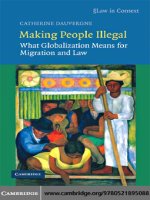cambridge university press united nations sanctions and the rule of law jan 2008 kho tài liệu bách khoa
Bạn đang xem bản rút gọn của tài liệu. Xem và tải ngay bản đầy đủ của tài liệu tại đây (3.69 MB, 575 trang )
This page intentionally left blank
United Nations Sanctions and the Rule of Law
The United Nations Security Council has increasingly resorted to
sanctions as part of its efforts to prevent and resolve conflict.
United Nations Sanctions and the Rule of Law traces the evolution of
the Security Council’s sanctions powers and charts the contours
of the UN sanctions system. It also evaluates the extent to which
the Security Council’s increasing commitment to strengthening
the rule of law extends to its sanctions practice. It identifies
shortcomings in respect of key rule of law principles and
advances pragmatic policy-reform proposals designed to ensure
that UN sanctions promote, strengthen and reinforce the rule of
law. In its appendices, United Nations Sanctions and the Rule of Law
contains summaries of all twenty-five UN sanctions regimes
established to date by the Security Council. It forms an invaluable
source of reference for diplomats, policy-makers, scholars and
advocates.
J E R E M Y M A T A M F A R R A L L is a Research Fellow at the Centre for
International Governance and Justice, in the Regulatory
Institutions Network at the Australian National University. He
worked for the United Nations from 2001 to 2006, serving as a
political officer in the UN Security Council in New York, on the
UN Secretary-General’s Mission of Good Offices in Cyprus and
with the UN Mission in Liberia. He received his Ph.D. in
International Law from the University of Tasmania Faculty of
Law, where he has also worked as a Postdoctoral Research Fellow.
CAMBRIDGE STUDIES IN INTERNATIONAL AND COMPARATIVE LAW
Established in 1946, this series produces high-quality scholarship in the fields
of public and private international law and comparative law. Although these
are distinct legal sub-disciplines, developments since 1946 confirm their
interrelation.
Comparative law is increasingly used as a tool in the making of law at
national, regional and international levels. Private international law is now
often affected by international conventions, and the issues faced by classical
conflicts rules are frequently dealt with by substantive harmonisation of law
under international auspices. Mixed international arbitrations, especially those
involving state economic activity, raise mixed questions of public and private
international law, while in many fields (such as the protection of human rights
and democratic standards, investment guarantees and international criminal
law) international and national systems interact. National constitutional
arrangements relating to ‘foreign affairs’, and to the implementation of
international norms, are a focus of attention.
The Board welcomes works of a theoretical or interdisciplinary character,
and those focusing on the new approaches to international or comparative law
or conflicts of law. Studies of particular institutions or problems are equally
welcome, as are translations of the best work published in other languages.
General Editors
James Crawford SC FBA
Whewell Professor of International Law, Faculty of Law, and
Director, Lauterpacht Research Centre for International Law,
University of Cambridge
John S. Bell FBA
Professor of Law, Faculty of Law, University of Cambridge
Editorial Board
Professor Hilary Charlesworth Australian National University
Professor Lori Damrosch Columbia University Law School
Professor John Dugard Universiteit Leiden
Professor Mary-Ann Glendon Harvard Law School
Professor Christopher Greenwood London School of Economics
Professor David Johnston University of Edinburgh
Professor Hein Ko¨tz Max-Planck-Institut, Hamburg
Professor Donald McRae University of Ottawa
Professor Onuma Yasuaki University of Tokyo
Professor Reinhard Zimmermann Universita¨t Regensburg
Advisory Committee Professor D. W. Bowett QC
Judge Rosalyn Higgins QC
Professor J. A. Jolowicz QC
Professor Sir Elihu Lauterpacht CBE QC
Professor Kurt Lipstein
Judge Stephen Schwebel
A list of books in the series can be found at the end of this volume.
United Nations Sanctions
and the Rule of Law
by
Jeremy Matam Farrall
CAMBRIDGE UNIVERSITY PRESS
Cambridge, New York, Melbourne, Madrid, Cape Town, Singapore, São Paulo
Cambridge University Press
The Edinburgh Building, Cambridge CB2 8RU, UK
Published in the United States of America by Cambridge University Press, New York
www.cambridge.org
Information on this title: www.cambridge.org/9780521878029
© Jeremy Matam Farrall 2007
This publication is in copyright. Subject to statutory exception and to the provision of
relevant collective licensing agreements, no reproduction of any part may take place
without the written permission of Cambridge University Press.
First published in print format 2007
ISBN-13 978-0-511-37729-7
eBook (EBL)
ISBN-13 978-0-521-87802-9
hardback
Cambridge University Press has no responsibility for the persistence or accuracy of urls
for external or third-party internet websites referred to in this publication, and does not
guarantee that any content on such websites is, or will remain, accurate or appropriate.
Contents
Preface
Abbreviations
Part I
1
2
4
6
7
8
1
3
14
The evolution of the UN sanctions
framework
43
From Aegina to Abyssinia: a prehistory of UN
sanctions
Sanctions under the UN Charter
Part III
5
Setting the scene
Introducing UN sanctions
Towards a pragmatic rule of law model for UN
sanctions
Part II
3
page xix
xxii
45
58
UN sanctions in practice
79
Establishing the legal basis for sanctions:
identifying threats and invoking Chapter VII
Delineating the scope of sanctions and
identifying targets
Fine-tuning sanctions: setting objectives,
applying time-limits and minimising
negative consequences
Delegating responsibility for sanctions
administration and monitoring
81
106
133
146
v
vi
CONTENTS
Part IV
Strengthening the rule of law
183
9 Rule of law weaknesses in the UN sanctions system
10 Strengthening the rule of law performance of
the UN sanctions system
11 Concluding remarks
185
Appendix 1: Summary of policy recommendations
244
Appendix 2: Summaries of UN sanctions regimes
247
Appendix 3: Tables
464
Bibliography
Index
493
524
230
241
Extended table of contents
Preface
Abbreviations
Part I
1
2
page xix
xxii
Setting the scene
1
1. Defining UN sanctions
2. Central contention and key objectives
3. The path ahead
Introducing UN sanctions
3
6
10
11
Towards a pragmatic rule of law model for UN
sanctions
14
1. The relevance of the rule of law to the
UN Security Council’s activities
1.1 The Council’s close relationship with and
reliance upon law
1.2 The increasing emphasis upon the rule of law
in Security Council practice
2. The promise and perils of the rule of law
2.1 The scholarly crisis concerning the rule of law
2.2 Salvaging the rule of law from scholarly crisis
3. Towards a pragmatic rule of law model for UN sanctions
3.1 The rule of law through the eyes of the Security
Council
3.2 The rule of law through the eyes of the
UN Secretary-General
3.3 Scholarly explorations of the relationship between
the Security Council and the rule of law
3.4 Constructing a pragmatic rule of law model for
sanctions decision-making
i. Transparency
vii
15
16
18
24
26
30
32
32
35
36
39
40
viii
EXTENDED TABLE OF CONTENTS
ii. Consistency
iii. Equality
iv. Due process
v. Proportionality
3.5 A framework for subsequent analysis
Part II
3
The evolution of the UN sanctions
framework
From Aegina to Abyssinia: a prehistory of UN sanctions
1. Sanctions in ancient and medieval times
2. Sanctions under classic international law
2.1 Retorsion
2.2 Reprisals
2.3 Pacific blockade
2.4 The possibilities and limitations of
pre-twentieth-century sanctions
3. Sanctions under the League of Nations system
3.1 The League of Nations sanctions provision
3.2 The League of Nations sanctions experiment
against Italy
4. Learning from the League’s experience
4
Sanctions under the UN Charter
1. A fresh approach to collective security
1.1 An incentive for the great powers: the veto
1.2 Incentives for lesser powers: the UN purposes
and principles
1.3 The UN’s principal organs
2. The UN Security Council’s sanctions powers
2.1 The sanctions trigger: Article 39
2.2 The UN Charter’s sanctions provision: Article 41
2.3 Other sanctions-related Chapter VII provisions:
Articles 48 and 50
2.4 The binding character of Article 41 sanctions
3. The question of the limits upon the Security Council’s
sanctions powers
3.1 Potential Charter-based limits on the Council’s
sanctions powers
3.2 Peremptory norms as a potential limit upon the
Council’s sanctions powers
3.3 The possibility of judicial review of Security
Council sanctions
3.4 The Security Council’s enduring power
41
41
41
41
42
43
45
45
47
48
49
50
51
52
53
54
56
58
58
59
60
61
62
63
64
65
65
68
68
71
73
75
EXTENDED TABLE OF CONTENTS
4. The Charter’s implementation lacuna and the organic
evolution of the UN sanctions system
Part III
5
UN sanctions in practice
Establishing the legal basis for sanctions: identifying
threats and invoking Chapter VII
1. Determining the existence of a threat to the peace,
breach of the peace or act of aggression
1.1 Must the Security Council make a determination
under Article 39 before applying sanctions?
1.2 Threats to the peace
i. Threats with a clear international dimension
(a) States with an aggressive history and the
potential to possess or produce weapons
of mass destruction
(b) International terrorism
(c) International conflict
(d) Interference
ii. Threats arising from internal crisis
(a) The denial of the right to self-determination
by a racist minority regime
(b) Apartheid
(c) General civil war
(d) Seizure of power from a democratically
elected government
(e) The use or threat of military force by rebel
groups against a government
(f) Serious humanitarian crises
(g) The violation of a minority’s fundamental
rights
1.3 Breaches of the peace
1.4 Acts of aggression
2. Invoking Article 41 and Chapter VII of the Charter
6
Delineating the scope of sanctions and identifying
targets
1. The many types of UN sanctions
1.1 Economic and financial sanctions
i. Comprehensive economic sanctions
(a) Humanitarian exemptions from
comprehensive sanctions
(b) Other exemptions from comprehensive
sanctions
ix
76
79
81
82
82
85
86
86
87
90
91
92
92
94
95
97
98
100
101
102
103
105
106
106
107
107
108
109
x
EXTENDED TABLE OF CONTENTS
ii. Particular economic sanctions
(a) Arms sanctions
(b) Sanctions against weapons of mass destruction
(c) Petroleum sanctions
(d) Sanctions on asbestos, iron ore, sugar, leather,
chrome, pig-iron, tobacco, copper, meat and
meat products
(e) Sanctions against trade in forms of transport:
aircraft, vehicle and watercraft sanctions
(f) Diamond sanctions
(g) Chemical sanctions
(h) Timber sanctions
(i) Luxury goods sanctions
iii. Financial sanctions
1.2 Non-economic sanctions
i. Diplomatic and representative sanctions
ii. Transportation sanctions
iii. Travel sanctions
iv. Aviation sanctions
v. Sporting, cultural and scientific
sanctions
vi. Telecommunications sanctions
2. Identifying targets
2.1 Single state targets
2.2 Multiple state targets
2.3 De facto state targets
2.4 Failed state targets
2.5 Sub-state targets
2.6 Extra-state targets
2.7 Individuals as targets
7
Fine-tuning sanctions: setting objectives, applying
time-limits and minimising negative consequences
1. Setting sanctions objectives
1.1 Ending a rebellion, invasion or external interference
1.2 Restoring a legitimate and/or democratically elected
government to power
1.3 Facilitating the exercise or protection of
human rights
1.4 Bringing about disarmament or arms control
1.5 Facilitating the establishment and consolidation
of peace
1.6 Addressing international terrorism
1.7 Promoting good governance
110
110
114
116
117
117
118
119
119
119
120
123
123
124
124
126
127
128
128
129
129
129
130
130
131
131
133
133
134
135
135
136
136
137
138
EXTENDED TABLE OF CONTENTS
2. Defining the temporal application of sanctions
2.1 Time-delays
2.2 Time-limits
3. Addressing the unintended consequences of sanctions
3.1 Security Council action to address the humanitarian
impact of sanctions upon civilian populations
i. The exemptions process
ii. Smart sanctions
iii. Humanitarian impact assessment
3.2 Security Council action to address the impact of
sanctions upon third states
8
Delegating responsibility for sanctions
administration and monitoring
xi
139
139
140
141
141
141
143
143
144
146
1. Sanctions committees
147
1.1 Composition
147
1.2 Mandates
148
i.
Reporting activities
149
ii. The administration of exemptions
150
iii. Considering requests for special assistance
under Article 50
151
iv. Sanctions monitoring
151
v. Improving sanctions implementation
152
vi. Liaising with other subsidiary organs
153
vii. Refining working methods
154
viii. Administering lists for targeted sanctions
155
ix. Considering the humanitarian impact of sanctions 155
1.3 Working methods
156
2. The Security Council Working Group on Sanctions
157
3. Disarmament commissions and commissions of inquiry
157
3.1 The Iraq Commissions: UNCC, UNSCOM, UNMOVIC
158
3.2 The International Commission of Inquiry on Rwanda 160
3.3 The Sudan International Commission of Inquiry
163
3.4 The Hariri International Independent Investigation
163
Commission
4. Bodies of experts: groups, committees, teams and
panels of experts
163
4.1 The Group of Experts on the Iraq sanctions regime
164
4.2 Ad hoc Panels on the Iraq sanctions regime
164
4.3 The Panel of Experts on UNITA sanctions
165
4.4 The Panel of Experts on the Sierra Leone
sanctions regime
166
4.5 The Afghanistan/Taliban/Al Qaida Committee
of Experts
167
xii
EXTENDED TABLE OF CONTENTS
4.6 The 1343 Liberia Panel of Experts
4.7 The Team and Panel of Experts on Somalia
4.8 The 1521 Liberia Panel of Experts
4.9 The DRC Group of Experts
4.10 The Sudan Panel of Experts
4.11 The Coˆte d’Ivoire Group of Experts
5. Monitoring bodies
5.1 The Iraq Export/Import Monitoring Mechanism
5.2 The UNITA Monitoring Mechanism
5.3 The Taliban and Al Qaida Monitoring Mechanism
5.4 The Taliban and Al Qaida Monitoring Team
5.5 The Somalia Monitoring Group
6. United Nations peacekeeping operations
Part IV
9
Strengthening the rule of law
Rule of law weaknesses in the UN sanctions system
1. Behind closed doors: the problem of transparency
1.1 Transparency in the Security Council’s
decision-making process
1.2 Transparency in Security Council decisions
i. Determination of threats to the peace
ii. Invoking the Charter basis for applying sanctions
iii. Articulating sanctions objectives
(a) Establishing peace and stability
(b) Securing the future and ongoing verification
of disarmament
(c) Ensuring that a target stops supporting
terrorism
1.3 Transparency in sanctions committees
2. A less than constant practice: the problem of consistency
2.1 Consistency and the objectives of sanctions regimes
2.2 Consistency and the scope of sanctions
2.3 Consistency and the Security Council’s use of
subsidiary bodies
i. The establishment of sanctions committees
ii. Commissions of inquiry, bodies of experts
and monitoring mechanisms
3. First among equals: the veto and the problem of equality
3.1 Equality as equal treatment
3.2 Equality as equal representation
4. Guilty until proven innocent? The problem of due process
4.1 Due process and states targets
168
170
171
172
173
173
174
174
176
176
177
179
180
183
185
185
186
189
190
195
196
196
197
198
202
205
206
207
210
210
211
211
212
213
217
217
EXTENDED TABLE OF CONTENTS
4.2 Due process and non-state targets
4.3 Due process and individuals
5. A disproportionate burden: civilian
populations and third states
5.1 Proportionality and civilian populations: minimising
the humanitarian impact of sanctions
5.2 Proportionality and individual targets
5.3 Proportionality and third states
10
Strengthening the rule of law performance
of the UN sanctions system
1.
2.
3.
4.
5.
11
Increasing transparency
Improving consistency
Promoting equality
Providing due process
Ensuring proportionality
Concluding remarks
Appendix 1: Summary of policy recommendations
1.
2.
3.
4.
5.
Increasing transparency
Improving consistency
Promoting equality
Providing due process
Ensuring proportionality
Appendix 2: Summaries of UN sanctions regimes
1. The 232 Southern Rhodesia sanctions regime
1. Constitutional basis
2. Objectives
3. Scope
4. Administration and monitoring
5. Termination
6. Conclusions
2. The 418 South Africa sanctions regime
1. Constitutional basis
2. Objectives
3. Scope
4. Administration and monitoring
5. Termination
6. Conclusions
3. The 661 Iraq sanctions regime
1. Constitutional basis
2. Objectives
3. Scope
xiii
219
219
223
224
228
228
230
230
232
234
236
239
241
244
244
245
245
245
246
247
247
248
249
249
251
253
253
255
255
257
258
259
260
261
261
262
264
265
xiv
EXTENDED TABLE OF CONTENTS
4.
5.
6.
7.
8.
9.
4. Administration and monitoring
5. Conclusions
The 713 former Yugoslavia sanctions regime
1. Constitutional basis
2. Objectives
3. Scope
4. Administration and monitoring
5. Termination
6. Conclusions
The 733 Somalia sanctions regime
1. Constitutional basis
2. Objectives
3. Scope
4. Administration and monitoring
5. Conclusions
The 748 Libya sanctions regime
1. Constitutional basis
2. Objectives
3. Scope
4. Administration and monitoring
5. Suspension and termination
6. Conclusions
The 757 sanctions regime against the Federal
Republic of Yugoslavia (Serbia and
Montenegro)
1. Constitutional basis
2. Objectives
3. Scope
4. Administration and monitoring
5. Suspension and termination
6. Conclusions
The 788 Liberia sanctions regime
1. Constitutional basis
2. Objectives
3. Scope
4. Administration and monitoring
5. Termination
6. Conclusions
The 820 Bosnian Serb sanctions regime
1. Constitutional basis
2. Objectives
3. Scope
4. Administration and monitoring
271
281
282
282
283
283
284
286
286
288
288
289
289
290
297
297
298
298
299
301
303
304
305
306
307
307
311
314
315
316
316
317
317
317
319
319
320
320
321
321
323
EXTENDED TABLE OF CONTENTS
10.
11.
12.
13.
14.
15.
5. Suspension and termination
6. Conclusions
The 841 Haiti sanctions regime
1. Constitutional basis
2. Objectives
3. Scope
4. Administration and monitoring
5. Termination
6. Conclusions
The 864 UNITA sanctions regime
1. Constitutional basis
2. Objectives
3. Scope
4. Administration and monitoring
5. Suspension and termination
6. Conclusions
The 918 Rwanda sanctions regime
1. Constitutional basis
2. Objectives
3. Scope
4. Administration and monitoring
5. Suspension of aspects of the Rwanda sanctions
regime
6. Conclusions
The 1054 sanctions regime against the Sudan
1. Constitutional basis
2. Objectives
3. Scope
4. Administration and monitoring
5. Termination
6. Conclusions
The 1132 Sierra Leone sanctions regime
1. Constitutional basis
2. Objectives
3. Scope
4. Administration and monitoring
5. Termination of aspects of the Sierra Leone
sanctions regime
6. Conclusions
The 1160 sanctions regime against the Federal
Republic of Yugoslavia
1. Constitutional basis
2. Objectives
3. Scope
xv
324
325
326
326
327
329
331
333
334
334
335
335
336
338
344
344
345
345
346
346
347
353
353
353
354
355
355
356
357
357
357
358
359
359
361
368
368
369
369
370
371
xvi
EXTENDED TABLE OF CONTENTS
16.
17.
18.
19.
20.
21.
4. Administration and monitoring
5. Termination
6. Conclusions
The 1267 sanctions regime against Afghanistan/the
Taliban/Al Qaida
1. Constitutional basis
2. Objectives
3. Scope
4. Administration and monitoring
5. Conclusions
The 1298 Eritrea and Ethiopia sanctions regime
1. Constitutional basis
2. Objectives
3. The scope of the 1298 sanctions regime
4. Administration and monitoring
5. Termination
6. Conclusions
The 1343 Liberia sanctions regime
1. Constitutional basis
2. Objectives
3. Scope
4. Administration and monitoring
5. Termination
6. Conclusions
The 1493 DRC sanctions regime
1. Constitutional basis
2. Objectives
3. Scope
4. Administration and monitoring
5. Conclusions
The 1521 Liberia sanctions regime
1. Constitutional basis
2. Objectives
3. Scope
4. Administration and monitoring
5. Termination of timber sanctions
6. Conclusions
The 1556 Sudan sanctions regime
1. Constitutional basis
2. Objectives
3. Scope
4. Administration and monitoring
5. Conclusions
372
374
374
374
375
376
377
381
393
395
395
396
397
398
399
400
400
400
401
402
404
409
410
411
411
412
412
415
418
418
419
420
421
423
429
429
430
430
431
431
433
438
EXTENDED TABLE OF CONTENTS
22. The 1572 Coˆte d’Ivoire sanctions regime
1. Constitutional basis
2. Objectives
3. Scope
4. Administration and monitoring
5. Conclusions
23. The 1636 Hariri sanctions regime
1. Constitutional basis
2. Objectives
3. Scope
4. Administration and monitoring
5. Conclusions
24. The 1718 North Korea sanctions regime
1. Constitutional basis
2. Objectives
3. Scope
4. Administration, monitoring and enforcement
5. Conclusions
25. The 1737 Iran sanctions regime
1. Constitutional basis
2. Objectives
3. Scope
4. Administration, monitoring and enforcement
5. Conclusions
Appendix 3: Tables
A UNSCR provisions referring to the rule of law
B UNSCR provisions establishing and terminating
UN sanctions regimes
C UNSCR provisions citing Chapter VII of the UN Charter
as the basis for sanctions-related action
D UNSCR provisions outlining the scope of sanctions
E UNSCR provisions outlining Sanctions Committee
mandates
F Reports by Sanctions Committees
G UNSCR provisions outlining the mandates of
sanctions-related expert and monitoring bodies
H Reports by sanctions-related expert and monitoring
bodies
Bibliography
Index
xvii
439
439
440
441
443
447
448
448
449
449
450
452
452
453
454
455
456
457
458
458
460
460
462
463
464
465
468
470
474
477
481
487
491
493
524
Preface
This book began life as a doctoral thesis. I originally expected the thesis
to focus less on the UN Security Council’s sanctions practice and more
on theoretical questions arising from the Council’s application of sanctions. However, early in my research I discovered that most books on UN
sanctions analysed sanctions from a broad policy perspective and did
not pay too much attention to the finer print of the provisions of
Security Council resolutions that establish and modify each UN sanctions regime. Although there were valuable studies of this type concerning individual sanctions regimes, there was no central source tracing
the evolution of the Security Council’s many sanctions regimes. I thus
began to prepare the summaries of UN sanctions regimes that feature in
Appendix 2. Once I had completed these summaries, I moved on to the
challenging assignment of describing and analysing the contours of the
UN sanctions system.
Just as I did not originally set out to describe the UN sanctions
system, neither did I intend to explore the relationship between
those sanctions and the rule of law. I had planned to analyse the
legitimacy of sanctions, which I still consider to be an extremely
important theme. But on 24 September 2003 I witnessed a Security
Council debate on justice and the rule of law, culminating in the
adoption of a Security Council presidential statement affirming the
vital importance of the rule of law in the Council’s work. I immediately
began to wonder whether the Council’s commitment to the rule of law
might be said to extend to its own sanctions system. How would the
Council’s sanctions practice measure up when viewed through a rule
of law lens? What lessons might be learned from such an analysis and
how might they be used to strengthen the Council’s future sanctions
policy and practice?
xix
xx
PREFACE
This book therefore has two basic aims: to describe the evolution of
UN sanctions and to examine the relationship between sanctions and
the rule of law. The book’s practical goal is to advance policy proposals
for improving the rule of law performance of UN sanctions. But my
major hope is modest: I hope that readers find the following pages
interesting and helpful, whether they are seasoned sanctions policymakers or students engaging with sanctions for the very first time.
I am indebted to many people, whose support, guidance and inspiration have helped to shape this book. I owe a particular debt to the
University of Tasmania Faculty of Law and my PhD supervisors:
Professor Stuart Kaye, for his exemplary mentorship; Professors
Donald Chalmers and Margaret Otlowski, for their kind and generous
support; and Professor Ryszard Piotrowicz, for his guidance with early
research. I would also like to thank my PhD examiners, Professors Ivan
Shearer and Gerry Simpson, for their helpful suggestions on improving
the manuscript.
My writing and thinking have benefited from the thoughtful and
challenging feedback of colleagues and friends. Warm thanks are due
to Nehal Bhuta, Michael Bliss, Hilary Charlesworth, Gino Dal Pont,
Peter Danchin, Laura Grenfell, John Langmore and Fred Soltau. My
practical understanding of Security Council decision-making was
enriched by working in the UN’s Security Council Affairs Division
from 2001 to 2004. My comprehension of how sanctions apply on the
ground was deepened by working with the UN Mission in Liberia from
2004 to 2006. I learned an enormous amount from UN colleagues,
including Ademola Araoye, Babafemi Badejo, Tatiana Cosio, Comfort
Ero, Susan Hulton, Nicole Lannegrace, Aleksandar Martinovic, Linda
Perkin, Joseph Stephanides, James Sutterlin, Satya Tripathi and
Raisedon Zenenga.
I have enjoyed strong institutional support while preparing this book.
The University of Tasmania Faculty of Law provided me with a generous
postdoctoral research fellowship, in order to begin refining the manuscript. The writing process has been concluded at the Australian
National University, where I enjoy warm support from colleagues at
the Centre for International Governance and Justice and the Regulatory
Institutions Network. I would also like to thank Finola O’Sullivan,
Brenda Burke and the copy-editing team at Cambridge for their diligent
work on this book.
Most of all, I thank from the bottom of my heart my wonderful
family. To Reia, Nicolas, Eloise and Eleonore Anquet and Kim and Bob
PREFACE
xxi
Henderson, thank you for your ever-cheerful encouragement. To
Stephanie and Lyndsay Farrall, thank you for your unstinting support
and for being such amazing role-models. And to my incredible wife Lyn
Nguyen Henderson, thank you for your keen proofreading eye, your
strategic advice and your boundless love and care.
Australian National University, Canberra, January 2007
Abbreviations
AJIL
AMIS
AU
AYBIL
BYIL
CPPCG
CSCE
CTC
CY
DJILP
DPRK
DRC
EC
ECOMOG
ECOWAS
EJIL
EU
FRY
FRYSM
GA
GEMAP
GIA
GRL
GYIL
xxii
American Journal of International Law
African Union Observer Mission in Sudan
African Union
Australian Yearbook of International Law
British Yearbook of International Law
Convention on the Prevention and Punishment of the
Crime of Genocide
Conference on Security and Cooperation in Europe
UN Counterterrorism Committee
Conference on Yugoslavia
Denver Journal of International Law and Policy
Democratic People’s Republic of Korea
Democratic Republic of the Congo
European Community
Monitoring Group of the Economic Community of West
African States
Economic Community of West African States
European Journal of International Law
European Union
Federal Republic of Yugoslavia
Federal Republic of Yugoslavia (Serbia and Montenegro)
General Assembly
Governance and Economic Management Assistance
Program
Governor’s Island Agreement
Goods Review List
German Yearbook of International Law
ABBREVIATIONS
HILJ
IAEA
IATA
ICAO
ICC
ICCPR
ICESCR
ICFY
ICIR
ICISS
ICJ
ICLQ
ICRC
ICTR
ICTY
IFOR
IGAD
ILJ
ILM
ILR
JIL
KFOR
LAS
LR
LURD
MODEL
MONUC
NATO
NJIL
NPT
NTGL
NYUJILP
OAS
OAU
OFFP
OHCHR
xxiii
Harvard International Law Journal
International Atomic Energy Agency
International Air Transport Association
International Civil Aviation Organization
International Criminal Court
International Covenant on Civil and Political Rights
International Covenant on Economic, Social and
Cultural Rights
International Conference on the Former Yugoslavia
International Commission of Inquiry on Rwanda
International Commission on Intervention and State
Responsibility
International Court of Justice
International and Comparative Law Quarterly
International Committee of the Red Cross
International Criminal Tribunal for Rwanda
International Criminal Tribunal for Yugoslavia
Multinational Implementation Force
Intergovernmental Authority on Development
International Law Journal
International Legal Materials
International Law Review
Journal of International Law
International Security Forces in Kosovo
League of Arab States
Law Review
Liberians United for Reconciliation and Democracy
Movement for Democracy in Liberia
United Nations Organization Mission in the DRC
North Atlantic Treaty Organization
Nordic Journal of International Law
Treaty on Non Proliferation of Nuclear Weapons
National Transitional Government of Liberia
New York University Journal of International law
and Politics
Organization of American States
Organization of African Unity
Oil-for-Food Programme
Office of the High Commissioner for Human Rights









